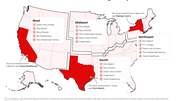News
Paul, the bakery chain, is bringing a taste of France to the United States
At Paul the focus is on using fresh ingredients to make traditional, old-world baked goods in a classic French style.
March 14, 2005
South Florida is the start of a major U.S. expansion for the bakery/café chain, whose history in France dates back to 1889. Paul already has more than 300 bakeries and cafés throughout Europe, the Middle East and Asia. The company's arrival in the United States brings a new player to the increasingly popular fast-casual segment of the restaurant industry.
Vladimir Alfa, chief executive of Paul USA, chose South Florida for the launch of the U.S. expansion because of the area's diversity. The Beacon Council also helped lure him to the area.
"The community is what made us come here," said Alfa, whose company Apety Group holds the franchise development rights for Paul in the Southeastern United States. "The community is more cosmopolitan than most places we looked at. People here travel a lot and many of them have seen Paul somewhere along their travels."
The history of Paul is what could make this breadmaker just that here in the U.S. With clear makings of Panera but with 100 years of recipies service standards and bakery pinache' this could become a houshold name in the casual dining segment here in the states.
The History of Paul
How it all began... "We all one day face major choices that will shape our lives. I seized two opportunities that marked decisive phases in this tremendous adventure." - Francis Holder -
In 1958,
After his father passes away, Francis Holder and his mother take over and expand the family bakery in Lille. PAUL - Place de Strasbourg in Lille "We were known for our wide selection of so-called 'viennois' breads at a time when people generally wanted only white bread. These are like the same fancy breads you find today in our shops."
In 1965,
the Nouvelles Galeries department store opened in Lille. Mass retailing began to expand in France. Francis Holder immediately offered to supply their bread. "I'd never negotiated with purchasing agents for big companies, and my approach as a small artisan was incongruous, to say the least. But I knew I'd rather have them as customers than as competitors!" The quality of his breads was instantly recognized: "I won the business because my bread didn't have any holes!"
From his bakery in Lambersart, Francis Holder began delivering bread to the growing number of mass retail chains, including Auchan, Nouvelles Galeries and subsequently Monoprix, under the "Moulin Bleu" brand. This was the first major step in the large-scale development of the company.
In 1970,
Francis Holder purchased an abandoned industrial site at La Madeleine, in the suburbs of Lille, transforming it into his first factory (the group now has three). The facility made bread for mass distribution outlets. Today, breads, viennoiseries, pastries and more recently sweet and savory pies and cakes are produced at the factories. The products are delivered unbaked and frozen, pre-baked fresh and pre-baked frozen to major chains such as Monoprix, Intermarché, Champion and Atac.
In 1972,
Francis Holder soon begins to feel a nostalgia for his roots as a baker. While continuing to run the Moulin Bleu, he transforms the original family shop in Lille, installing a wood stove and opening the baking area so that customers can see the bread being baked. This simple yet novel concept is at the heart of the success Paul enjoys today: the breads are baked according to time-honored traditional methods: kneading, fermentation, shaping, proofing, baking... letting consumers rediscover the true quality and taste of really good bread.
The concept created in Lille proves a success. The Paul chain develops with the expansion of malls in France. Francis Holder instantly grasps the potential of this type of business, and over the years Paul's reputation gradually grows throughout France. This is the second important phase in the company's development. "Back then there was no key money to pay, and a franchise was easier and less expensive to set up than today... The formula for opening a new Paul bakery is actually quite simple: Rule number one: location. Rule number two: location. Rule number three: location!"
Next, Paul franchises began going beyond malls. Francis Holder and his teams take over prime locations in city centers, in Paris and in major cities across France.
In 1993,
The bakeries with black storefronts make their appearance, introducing a new style and a new concept. "We didn't want to change the look every four years just to seem trendy. Our customers feel comfortable in our boutiques because they give the impression of always having been there. We express the unique French art de vivre."
At the same time Francis Holder becomes involved further upstream in the process, in the growing of grains for his breads, and develops his range of specialty breads. He meets with millers, who don't at first see how they can benefit from his concept. "For my bread I wanted a rustic variety of tender winter wheat grown according to the principles of sustainable agriculture. Camp Rémy wheat yields 30 percent less than other grains. For farmers and millers working with us, we had to pay more to make up the difference!" Today, over 300 French farmers plant over 3,500 hectares (8,650 acres) for Paul, following extremely precise specifications.
Francis Holder has always remained faithful to the lessons his father taught him regarding respect for the product: "When I was an apprentice to my father I was responsible for the flour loft. We gave our flour a month on the floor to fully mature. And we still do the same at Paul."
Francis Holder and his teams ensure the quality of the brand's products each and every day, from the recipes and quality of service to the décor of the boutiques. He never loses touch with his first passion of making bread, working each week with the people who carry on the tradition of creating great bread.
And while he's not about to retire, Francis Holder has already assured that this proud tradition will be perpetuated: "My sons are working with me to carry on this tremendous adventure."
Paul Today
Warm and refined atmosphere
The country-style decor has been deliberately chosen by PAUL. The building materials used, the color scheme, the furnishings are all designed to complement and symbolize the traditional skill of the baker.
The brick, wood and traditional stone used in PAUL bakeries all represent the genuine tradition that guides PAUL in all that it bakes and offers.
Patina, kitchen implements, terracotta tiles, sculpted woodwork and old engravings — all recall the world of yesteryear. Each new oven, with the smell of freshly-baking bread, is a friendly and welcome addition wherever it is installed.
Part of PAUL's genius has been to adapt this basic concept to all sorts of sites. Each shop has been designed by their own interior design experts.
In planning the decor of each shop, the architects and designers seek a happy marriage between the limits imposed by the particular locality and the PAUL spirit of tradition.
This means that while each shop has its own personality, there is still the charm of the PAUL style, thanks to the careful choice of decoration and old-fashioned furnishings. Wherever the shop is situated in a place of particular historic interest, both shopfront and interior decor are designed to take this into account.












